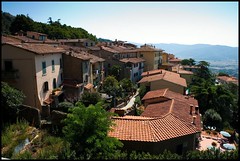Can we balance the old and new as a place evolves?

Posted December 28, 2011 at 1:25PM
We change with time, and so do our communities. In some cases the evolution may seem lightning-fast, in others slow; in some cases change brings obvious improvement, but there is frequently something lost as well. Like it or not, there is no stopping. So how do we remain who we are if our purpose changes? In the case of communities, how do we manage change so as to retain what is most valuable of a place's character?
That is a question faced by neighborhoods, towns and cities all over the world, and it is something that I have been writing about often - just a couple of weeks ago with respect to a suburbanizing Georgia county; repeatedly with respect to Cincinnati's once-downtrodden but now-revitalizing Over-the-Rhine neighborhood; more than once about my own home town. There is no fixed answer, of course, though some friends of mine have some excellent thoughts on the subject, particularly with regard to urban and urbanizing districts. In an essay we published in 2010, my friend Lee Epstein and I took a stab at delineating some of the ingredients important to keeping a special small town - including those we like to visit - special.
The question of balance becomes particularly acute in places perceived as having special historic or cultural value. If we do not allow them to evolve with time, chances are they will wither and die: DC's iconic Georgetown neighborhood, for example,  cannot be expected to function the same way today as it did when the now-historic district was a tobacco port along the Potomac River and the Chesapeake and Ohio Canal. Over-the-Rhine was neglected, and suffered severe loss of population, safety, and historic properties.
cannot be expected to function the same way today as it did when the now-historic district was a tobacco port along the Potomac River and the Chesapeake and Ohio Canal. Over-the-Rhine was neglected, and suffered severe loss of population, safety, and historic properties.
Many places can and do survive economically with tourism. Indeed, I like my friend Steve Mouzon's "Tourist Test," which holds that a place not specifically built for visitors but that attracts them is likely to have intrinsic value. If it's a place no one wants to visit, its enduring value may be minimal. Having grown up in a smallish city so associated with visitors that its minor league baseball team has long been known as the Tourists, I get that. But can places be not only starved to death but also loved to death?
We have a tendency to like special places as we found them, and resist their change. Indeed, we may even feel a sense of ownership as we grow fond of a lovely community we have encountered through travel. We can fall prey to a sort of liberal snobbery with regard to our favorites: we want to visit but don't want others to, at least not very much. That may be natural, but is it realistic? Is it even ethical?
Some of these questions are posed in a film-in-the-making called The Genius of a Place, conceived and directed by American filmaker Sarah Marder. It profiles Cortona, the Italian hillside city made famous in Frances Mayes's 1996 book Under the Tuscan Sun, and by the 2003 film of the same name.  Marder first visited Cortona 25 years ago, and has come to love it. (Cortona is in many respects following in the footsteps of the French Provencal village of Menerbes, made famous by Peter Mayles's wildly popular 1989 book A Year in Provence.)
Marder first visited Cortona 25 years ago, and has come to love it. (Cortona is in many respects following in the footsteps of the French Provencal village of Menerbes, made famous by Peter Mayles's wildly popular 1989 book A Year in Provence.)
According to Marder, Cortona now receives some 400,000 visitors per year. That is not an unworkable number for a city of 22,000 whose principal economic base is now tourism. (By comparison, the much smaller but still lovely hill towns in the French Luberon region - which includes Menerbes - are said to accommodate around 300,000.) But it is a substantial number nonetheless, large enough to be important economically, to mark a change from the city's historical purpose and function, and to make one want to get serious about stewardship, which is Marder's point. I suppose an irony is that many of us who see the film may (1) be struck by its message of loss due to the changes wrought by its new tourist economy, but (2) also want to add our names to its list of visitors as a result of the film.
(My friend Chuck Wolfe wrote about The Genius of a Place on his excellent blog, myurbanist.)
There's a well-produced introduction to Marder's film and its themes in the trailer below, and I would be remiss if I didn't also mention her other pressing concern, which is that she wants to finish the film in time for the 2013 Sundance festival and is seeking funding support to help make that happen:
Move your cursor over the images for credit information.
Please also visit NRDC’s sustainable communities video channel.
